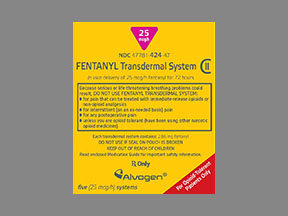
Duragesic-25 Coupons & Savings Card – Discount Prices from $62.22
Brand for: Fentanyl
My prescription
Edit
25MCG/HR, Fentanyl (30 Patch 72 Hours)
Select pharmacy

CVS
$62.22
COUPON PRICE
Walgreens
$118.00
COUPON PRICE
Rite Aid
$172.05
COUPON PRICE
Albertsons
$188.53
COUPON PRICEDuragesic-25 savings card
Show this card to your pharmacist
CVS
$62.22
BIN
ID
PCN
GRP
019876
LH79F507D3
CHIPPO
LHX
Powered by
Duragesic-25 dosage forms
| Dosage | Quantity | Price from | Per unit |
|---|---|---|---|
| 25MCG/HR | 30 Patch 72 Hours | $62.22 | $2.07 |
Duragesic-25 Warnings
Fentanyl is a powerful opioid medication that poses significant risks if not used correctly. Below are the safety considerations and warnings associated with its use:
Risk of Abuse and Addiction: Fentanyl carries a high potential for misuse and addiction, which can result in severe consequences, including overdose and death. This risk is increased in individuals with a history of substance abuse or mental health disorders. Always use fentanyl exactly as prescribed by your healthcare provider.
Respiratory Depression: Fentanyl can cause life-threatening slow or shallow breathing, especially when starting treatment, increasing the dose, or in those not tolerant to opioids. Immediate medical attention is required if symptoms such as shortness of breath, extreme drowsiness, or bluish skin occur. Those with pre-existing breathing conditions like COPD or asthma should exercise caution.
Overdose Risk: Taking more fentanyl than prescribed or using it improperly can lead to a fatal overdose. Signs of overdose include unresponsiveness, extremely slow breathing, and cold skin. Keep naloxone available as an emergency treatment for opioid overdose and ensure family members know how to use it.
Temperature Sensitivity: Exposure to heat can increase fentanyl release from patches, leading to overdose. Avoid external heat sources such as heating pads, hot baths, or rigorous exercise while using the patch.
Interactions with Alcohol and Other Drugs: Combining fentanyl with alcohol or medications that depress the central nervous system (like benzodiazepines) can intensify its sedative effects, increasing the risk of severe side effects or death.
Use in Specific Populations: Fentanyl is not recommended for children under 2 years or for the treatment of mild, short-term, or post-surgical pain. Pregnant women should use fentanyl only if necessary, as it can harm the fetus or lead to withdrawal symptoms in newborns.
Drug Interactions: Fentanyl interacts with various medications, potentially enhancing its effects or leading to serotonin syndrome when used with drugs that increase serotonin levels. Always inform your healthcare provider of all medications you are taking.
Physical Dependence and Withdrawal: Long-term use can lead to physical dependence. Do not abruptly stop the medication without consulting your healthcare provider to avoid withdrawal symptoms.
Low Blood Pressure and Heart Rate: Fentanyl can cause low blood pressure and a slow heart rate, leading to dizziness or fainting. Be cautious when standing up from sitting or lying down.
Seizures: Individuals with a history of seizures should be aware that fentanyl may increase seizure risk.
Emergency Protocols: In the event of accidental exposure or overdose, seek immediate medical assistance. Keep fentanyl patches out of reach of children and pets to prevent accidental exposure.
By adhering to these guidelines and consulting with healthcare professionals, patients can help ensure safe and effective use of fentanyl.
Duragesic-25 Side Effects
When using this medication, some common side effects may include nausea, vomiting, sleepiness, dizziness, trouble sleeping, constipation, excessive sweating, tiredness, and feeling cold. These effects are often mild and may lessen over time. However, if they persist or worsen, consult your healthcare provider. Additionally, some individuals might experience headache, diarrhea, stomach pain, dry mouth, fast heartbeat, feeling unwell, weakness, muscle spasms, numbness or tingling in the arms or legs, itching, rash, anxiety, and confusion.
While rare, there are more serious side effects that necessitate immediate medical attention. These include dangerously slow breathing, characterized by breathing difficulties and bluish-colored lips or extremities, and symptoms of overdose, such as extreme sleepiness, slowed breathing, and cold or clammy skin. Another serious concern is opioid withdrawal, which can present as anxiety, suicidal thoughts, restlessness, irritability, runny nose, yawning, sweating, chills, and wide pupils.
An allergic reaction to this medication is very serious but uncommon. Symptoms such as a red itchy rash, shortness of breath, chest tightness, and swelling of the lips, tongue, throat, face, or eyes require urgent medical care. Lastly, be aware of serotonin syndrome, a rare but severe condition marked by fast heartbeat, hallucinations, loss of coordination, severe dizziness, nausea, vomiting, diarrhea, muscle twitching, unexplained fever, and unusual agitation or restlessness. If you experience any of these symptoms, seek medical help immediately.
Duragesic-25 Interactions
When using Fentanyl, be aware of potential interactions with other medications. Certain pain medications like Butorphanol, Nalbuphine, and pentazocine, as well as drugs like Naltrexone and samidorphan, can interact with fentanyl. Additionally, substances affecting fentanyl’s removal from your body, such as azole antifungals (Itraconazole, Ketoconazole), calcium channel blockers (diltiazem, Verapamil), HIV protease inhibitors (nelfinavir), macrolide antibiotics (Erythromycin), Mifepristone, Nefazodone, rifamycins (Rifabutin), Ritonavir, and some seizure medications (Carbamazepine, Phenytoin) may alter its effects.
Avoid combining fentanyl with MAO inhibitors like isocarboxazid, Linezolid, Metaxalone, methylene blue, moclobemide, phenelzine, procarbazine, Rasagiline, safinamide, Selegiline, and Tranylcypromine. These combinations can lead to serious, possibly life-threatening interactions. It’s generally advised not to use MAO inhibitors for at least two weeks before starting fentanyl.
The likelihood of severe side effects such as shallow breathing and intense drowsiness increases if fentanyl is used alongside other substances with similar effects, including other opioids (codeine, hydrocodone), alcohol, marijuana, sleep or anxiety medications (Alprazolam, Lorazepam, Zolpidem), muscle relaxants (Carisoprodol, Cyclobenzaprine), or antihistamines (Cetirizine, diphenhydramine). Be sure to inform your healthcare provider about any medications you are taking to avoid these risks.
There is an increased risk of serotonin syndrome when fentanyl is taken with drugs that elevate serotonin levels, such as MDMA, St. John's wort, and certain antidepressants (SSRIs like Fluoxetine/paroxetine, SNRIs like Duloxetine/Venlafaxine). This risk is higher when starting or increasing doses of these medications.
Fentanyl may also interfere with certain lab tests, potentially causing inaccurate results. Ensure that all healthcare and laboratory personnel are aware of your fentanyl use. Always consult your doctor or pharmacist for personalized advice on managing these interactions safely.
What is DUROGESIC 25 mg used for?
DUROGESIC 25 mg is used for the management of severe chronic pain that requires continuous, long-term opioid treatment and for which other pain management options are inadequate. It is typically prescribed for patients who are opioid-tolerant.
Is DURAGESIC discontinued?
Duragesic, a brand name for the fentanyl transdermal patch, has not been discontinued. It is still available by prescription for managing severe chronic pain in patients who require continuous opioid analgesia. However, availability may vary by location, and it's important to consult with a healthcare provider or pharmacist for the most current information.
Where do you apply DUROGESIC?
DUROGESIC, a transdermal patch, should be applied to a flat, non-irritated, and non-hairy area of the skin on the upper body or upper arm. The skin should be clean and dry before application. It is important to avoid areas with cuts, irritation, or excessive hair. If necessary, hair can be clipped but not shaved. The patch should be pressed firmly in place with the palm of the hand for about 30 seconds to ensure it adheres properly.
Where is the best place to put a transdermal patch?
The best place to apply a transdermal patch is on a clean, dry, and hairless area of the skin. Common recommended sites include the upper arm, chest, back, or the side of the abdomen. It is important to avoid areas with cuts, irritation, or excessive hair. The patch should be applied to a different site each time to prevent skin irritation.
Is DURAGESIC a schedule 2 drug?
Yes, DURAGESIC, which contains fentanyl, is classified as a Schedule II controlled substance in the United States. This classification indicates that it has a high potential for abuse, which may lead to severe psychological or physical dependence.
